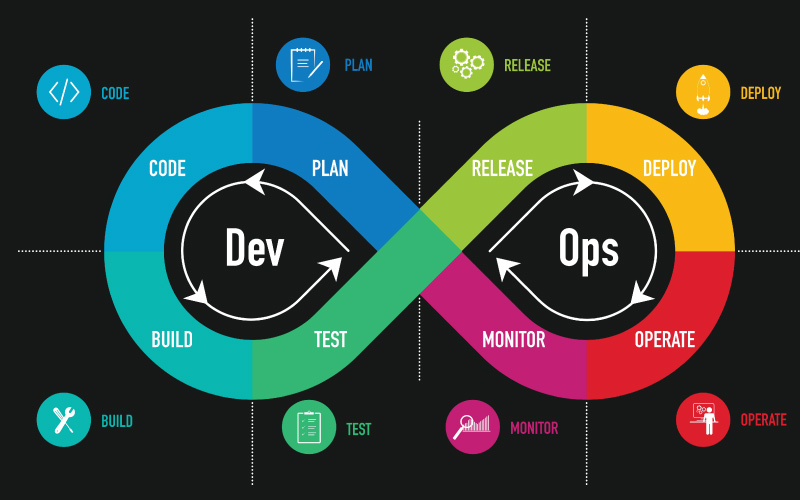Everything You Need To Know About DevOps Process

The DevOps process has all the components that make it one of the most popular agile methodologies among IT organizations.
This software development approach combines development and operations teams. This will eventually improve an organization's ability to deliver applications and services more quickly, reducing time to market.
This blog will discuss every aspect of the DevOps process, including DevOps challenges, benefits of DevOps, DevOps lifecycle, and DevOps working. We are confident that reading this blog all the way to the end will significantly improve your understanding of DevOps.
How does DevOps work?
In the DevOps process, the work is divided into an infinite loop of six phases, namely– plan, build, deploy, monitor, operate, and continuous feedback. A project progresses from one phase to the next until it is completed.
Moreover, unlike traditional methods, the development and operations teams in the DevOps process do not work independently. Rather, they collaborate as a single team. Both teams constantly collaborate with each other, as well as with other project teams and stakeholders.
They strive to develop features as quickly as possible and release them to the market in order to meet customer demands, while facilitating customers with the latest features.
What are the Key Challenges of the DevOps Process?
As with any new concept, implementing DevOps has its own set of challenges, ranging from embracing new tools to measuring success to high initial costs.
The following are the five major DevOps challenges
A. Transitioning from legacy applications to microservicesThe first major challenge that organizations or teams face when embracing the DevOps process is transitioning from legacy applications to microservices.
Although moving to microservices allows for faster software development, switching to a new environment is often challenging. Organizations are expected to have continuous integration and continuous delivery (CI-CD), and the necessary support in place to deal with these challenges.
B. Incorporating new tools and technologiesTo reap the maximum benefits of the DevOps process, you must invest in and use the most advanced IT tools and technologies for DevOps operations.
At the same time, it is necessary that you invest in the right set of tools that are compatible with one another, as well as with the requirements of your project. Overall, choosing and implementing the right set of tools will be a bit challenging.
C. Establishing a Center of Excellence (CoE)All information related to DevOps projects must be properly documented so that if any member working on the project leaves the organization, the project's progress is not hampered.
One solution to this problem is to establish a Center of Excellence (CoE). However, in order to develop a Center of Excellence, you will need experts who are well-versed in the DevOps process and its various facets.
D. Measuring success with the right KPIsIt is critical that a project which has been developed using DevOps methodology should be completed on time and successfully.
However, the project's success is determined by a number of factors or key performance indicators (KPIs) such as team velocity, lead time, cycle time, customer satisfaction, release burndown, and others. This means, as a beginner, defining the KPIs for the success of a DevOps process might be difficult for you.
E. Higher initial implementation costsAlthough the DevOps methodology is a cost-effective software development approach, in the long run, the initial implementation costs can be pretty high for small and medium-sized businesses.
At the initial stage, you will be required to invest in a variety of operational and development tools, as well as other resources.
The DevOps Lifecycle and Roadmap

The DevOps lifecycle or DevOps roadmap consists of six stages:
A. Continuous development
B. Continuous testing
C. Continuous integration
D. Continuous deployment
E. Continuous monitoring
F. Continuous feedback
Let's take a quick look at what happens in each phase.
A. Continuous developmentContinuous development is the first stage of the DevOps process lifecycle, which entails planning and coding.
At this stage, things such as how the project will be developed, when the features will be released, teams, and other elements are thought of. Once that is completed, the development team will begin writing code for the application.
B. Continuous testingAfter the code is written, it is tested to find and fix bugs in the next phase. To ensure the completeness, correctness, and effectiveness of the software, the code is tested in multiple ways.
Testers use advanced testing automation tools. After passing all the tests, the code is integrated with the existing code. The next phase of the DevOps process lifecycle is continuous integration.
C. Continuous integrationAt this point, the developers integrate the newly developed code with the existing code. This exercise is typically performed once a month or whenever needed. Every commit is then built, allowing for early detection of any problems.
One of the popular tools used at this stage is Jenkins. Whenever there is a change in the Git repository, Jenkins retrieves the updated code and prepares an executable build of that code.
D. Continuous deploymentThe fourth phase in the DevOps lifecycle is continuous deployment. At this point, the code is deployed to the production servers.
Here, configuration management and containerization tools are used to ensure that code is correctly deployed on all servers. Configuration management helps manage all the configurations of the environments in which the software application runs.
E. Continuous monitoringContinuous monitoring is the final stage of the DevOps roadmap. As the name implies, at this stage, you continuously monitor the application's performance.
Every critical piece of information about your software is recorded and analyzed. This phase is critical in ensuring the application's reliability and security. At this stage, all system errors are resolved.
F. Continuous feedbackThis stage in the DevOps framework is quite crucial. During this stage, automated performance feedback and issues experienced by the end user are shared as a continuous system. This presents opportunities for the end customers to share their feedback.
What are the Benefits of DevOps Methodology?
The following are some of the major benefits of the DevOps process:
A. Improved collaborationThe first advantage organizations enjoy from implementing the DevOps process is improved collaboration. In the DevOps culture, the developer and operational teams are merged and they collaborate. They work closely, share ideas and responsibilities, and take ownership of each task
B. Reduced time-to-marketSince the teams work collaboratively in the DevOps process, they can develop a product in a short period of time. In this software development approach, microservices and continuous delivery enable teams to take ownership of services and release updates more quickly.
C. Productive workforceThanks to established processes and clear prioritization of the DevOps process, development and operations teams can manage their work better. The organized work allocation, shared responsibilities, and improved collaboration will contribute in making the workforce more productive.
D. Faster delivery of new featuresAccording to the DORA 2019 State of DevOps report, DevOps teams deploy 208 times more frequently and 106 times faster than traditional agile development teams. New features or releases are developed much faster in a DevOps work culture than in a traditional development environment.
E. Higher customer satisfactionSince the DevOps process enables you to quickly fix bugs or release new features to the market, it ultimately makes customers happy with your product. Another factor contributing to higher customer satisfaction is complete transparency and seamless communication among DevOps teams, which reduces downtime and helps resolve issues faster.
What are the Benefits of DevOps Methodology?
What is a DevOps tool?A DevOps tool is any tool that helps automate and accelerate the DevOps process. Some DevOps tools examples are Jenkins, Docker, and Git.
What are the six DevOps lifecycle phases?The six phases of the DevOps lifecycle are Continuous Development, Continuous Testing, Continuous Integration, Continuous Deployment, Continuous Monitoring, and Continuous Feedback.
What is DevOps methodology?DevOps is a software development methodology that integrates software development (Dev) and operations (Ops) teams. The goal is to improve team collaboration and deliver products as quickly as possible.
What is the main objective of DevOps process?The main objective of the DevOps methodology is to create a cohesive software development team that collaborates closely and develops products in less time while also providing continuous value to customers.
What's the difference between Agile and DevOps methodologies?The main difference between Agile and DevOps processes is that, whereas DevOps is a practice of bringing development and operations teams together, Agile emphasizes collaboration between developers and product management.
Thanks for subscribing to our latest blogs, thought leadership and other product updates!
Read our Privacy Notice to know more. You can opt-out of all communications anytime.
